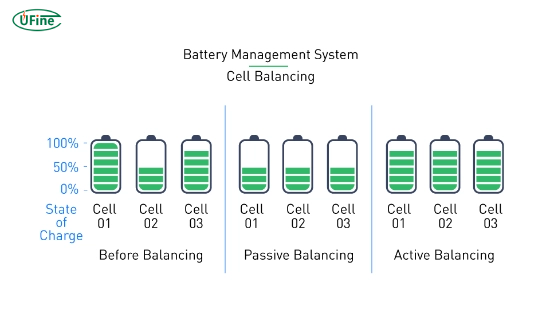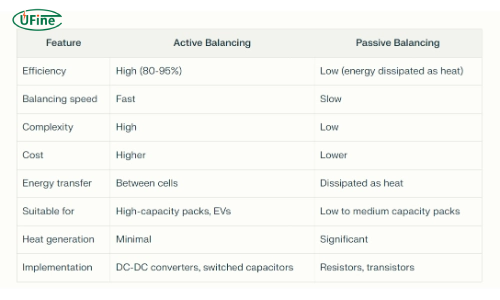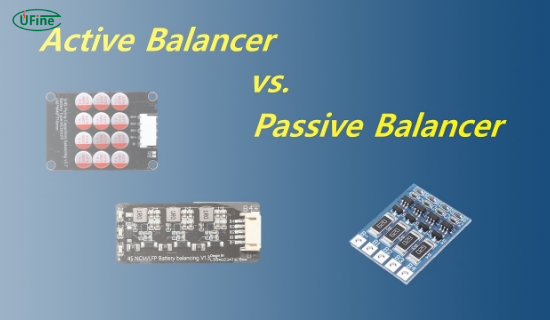Battery balancing and battery balancers are crucial in optimizing multi-cell battery packs’ performance, longevity, and safety. This comprehensive guide will delve into the intricacies of battery balancing, explore various balancing techniques, and provide insights into choosing the correct battery balancer for your needs.
Part 1. What is battery balancing?
Battery balancing equalizes the state of charge (SOC) across all cells in a multi-cell battery pack. This technique maximizes the battery pack’s overall capacity and lifespan while ensuring safe operation.
Due to manufacturing variations, temperature differences, and usage patterns, individual cells can develop slight differences in capacity and charge levels in a multi-cell battery pack. Over time, these discrepancies can lead to reduced overall pack capacity, decreased performance, and potential safety hazards.
Battery balancing aims to address these issues by:
- Equalizing the charge levels across all cells
- Preventing overcharging or over-discharging of individual cells
- Maximizing the usable capacity of the battery pack
- Extending the overall lifespan of the battery
Designing a battery balancing system
Designing an effective battery balancing system requires careful consideration of several factors:
- Battery chemistry: Different battery chemistries (e.g., lithium-ion, lead-acid, nickel-metal hydride) have unique characteristics and balancing requirements.
- Number of cells: The balancing system becomes more complex with the number of cells in the battery pack.
- Balancing method: Choose active and passive balancing techniques based on the application requirements.
- Balancing current: Determine the appropriate balancing current to achieve efficient equalization without compromising safety.
- Monitoring and control: Implement accurate cell voltage, temperature monitoring, and intelligent control algorithms.
- Safety features: Incorporate protection mechanisms against overcharging, over-discharging, and thermal runaway.
Part 2. How does battery balancing work?
Battery balancing works by redistributing charge among the cells in a battery pack to achieve a uniform state of charge. The process typically involves the following steps:
- Cell monitoring: The battery management system (BMS) continuously monitors the voltage and sometimes temperature of each cell in the pack.
- Imbalance detection: The BMS identifies cells with higher or lower charge levels compared to the average.
- Balancing activation: When the system detects an imbalance, the balancing circuit activates for the affected cells.
- Charge redistribution: Depending on the balancing method (active or passive), the charge is either removed from higher-charged cells or transferred between cells.
- Equalization: The process continues until all cells reach a similar state of charge within a specified tolerance.
- Continuous monitoring: The BMS continues to monitor and balance the cells throughout the charge and discharge cycles.
Part 3. Types of battery balancing
There are two main battery balancing techniques: passive and active. Each method has advantages and limitations, making it suitable for different applications.
Active vs. passive balancing
Passive balancing is the more straightforward and more common method. It works by dissipating excess energy from higher-charged cells through resistors until all cells reach the same voltage level. While cost-effective and easy to implement, passive balancing is less efficient and generates heat.
On the other hand, active balancing transfers energy between cells using more complex circuitry, such as DC-DC converters or switched capacitors. This method is more efficient and faster but comes at a higher cost and complexity.
Part 4. Why Battery Balancer is Critical for Modern Energy Systems?
In today’s energy-dependent world, battery balancers play a pivotal role in:
- ✅ Extending battery lifespan by 30-50% (industry studies show)
- ✅ Preventing 80% of premature battery failures
- ✅ Increasing usable capacity by 15-25%
- ✅ Meeting strict safety standards for lithium batteries
Part 5. Applications of battery balancing
Battery balancing is crucial in various applications that use multi-cell battery packs:
- Electric vehicles (EVs): Battery balancing ensures optimal EV battery packs’ performance, range, and longevity.
- Renewable energy storage: Large-scale battery systems for solar and wind energy storage benefit from efficient balancing.
- Portable electronics: Laptops, smartphones, and tablets use battery balancing to maximize battery life and safety.
- Power tools: Cordless power tools rely on balanced battery packs for consistent performance.
- Aerospace: Battery-powered systems in aircraft and spacecraft require precise balancing for reliability and safety.
- Medical devices: Implantable and portable medical equipment use battery balancing for extended operation.
- Robotics: Battery-powered robots and drones benefit from balanced power sources for optimal performance.
Part 6. Battery balancer explained: Core component for smart energy management
A battery balancer is an intelligent device that continuously monitors and optimizes charge distribution in multi-cell battery systems. Acting as the brain of modern battery management, it ensures:
| Feature | Basic Balancer | Advanced Balancer |
|---|---|---|
| Balancing Current | ≤100mA | 500mA-2A |
| Efficiency | 60-70% | 90-95% |
| Balancing Method | Passive Only | Active/Passive Hybrid |
Modern battery balancers integrate with IoT platforms, providing real-time data on:
- Cell voltage differentials (±0.5mV accuracy)
- Temperature gradients across the pack
- State-of-health (SoH) analytics
Part 7. How do battery balancers work?
Battery balancers work by continuously monitoring the voltage of each cell in a battery pack and taking action to equalize the charge levels when imbalances are detected. The specific operation depends on whether it’s a passive or active balancer:
1. Passive balancers:
- Monitor cell voltages
- Identify cells with higher voltage
- Activate bypass resistors for higher-voltage cells
- Dissipate excess energy as heat until voltages equalize
2. Active balancers:
- Monitor cell voltages
- Identify cells with higher and lower voltages
- Activate energy transfer circuits (e.g., DC-DC converters)
- Move charge from higher-voltage cells to lower-voltage cells
- Continue balancing until all cells reach a similar voltage
Both balancers typically operate during charging, although some advanced systems may also balance during discharge or idle periods.
Part 8. Types of battery balancers
Battery balancers can be categorized based on their balancing method and implementation:
1. Passive balancers:
- Resistive balancers
- Transistor-based balancers
2. Active balancers:
- Switched capacitor balancers
- Inductive balancers
- Transformer-based balancers
- Buck-boost converter balancers
3. Integrated balancers:
- Built into battery management ICs
- Standalone balancing modules
4. Programmable balancers:
- Microcontroller-based balancers with customizable algorithms
5. Cell-to-cell balancers:
- The balance between adjacent cells
6. Cell-to-pack balancers:
- Balance individual cells against the entire pack
Part 9. How do you choose the correct battery balancer?
Selecting the appropriate battery balancer depends on several factors:
- Battery chemistry: Ensure compatibility with the specific battery type (e.g., lithium-ion, LiFePO4, lead-acid).
- Number of cells: Choose a balancer that supports the required number of cells in series.
- Balancing current: Consider the required balancing speed and efficiency.
- Balancing method: Decide between passive and active balancing based on application requirements and budget.
- Integration: Determine if a standalone balancer or an integrated BMS solution is more suitable.
- Monitoring capabilities: Evaluate the precision and features of the cell voltage monitoring system.
- Safety features: Ensure the balancer includes necessary protection mechanisms.
- Communication interfaces: Check compatibility with existing systems or data logging and control requirements.
- Environmental conditions: Consider operating temperature range and environmental protection for the intended application.
- Cost: Balance the features and performance with budget constraints.
Part 10. FAQs about Key battery balancer
What is the main purpose of a battery balancer?
A battery balancer performs three critical functions:
- Equalize cell voltages during charging cycles
- Prevent overcharge/over-discharge of individual cells
- Maximize total energy storage capacity (typically by 15-25%)
How does a battery balancer extend battery life?
Quality balancers can increase battery lifespan by 30-50% through:
- Reducing cell stress from voltage imbalances
- Maintaining optimal state-of-charge (SOC) range
- Preventing thermal runaway situations
Can I add a balancer to an existing battery pack?
Yes, if the battery meets these requirements:
- Accessible cell terminals for voltage monitoring
- Compatible voltage range (e.g., 12V-48V systems)
- Sufficient space for balancer installation
How much does a professional battery balancer cost?
Pricing varies by capability:
- Basic passive balancers: $20-$50
- Advanced active balancers: $100-$300
- Industrial-grade systems: $500+
What maintenance do battery balancers require?
Modern balancers typically need:
- Annual firmware updates
- Monthly visual inspection
- Quarterly performance calibration
Related Tags:
More Articles

How to Choose the Best Floor Scrubber Battery for Commercial Cleaning?
Selecting the ideal floor scrubber battery ensures a long runtime, rapid charging, and minimal maintenance for efficient commercial cleaning operations.
Battery for Blower vs Battery for Leaf Vacuum: Which One Should You Choose?
Battery for blower vs leaf vacuum—learn the key differences in power, fit, and runtime to choose the right battery for your outdoor tool needs.
How to Choose the Right Battery for Blower?
Choosing the right blower battery? Consider voltage, capacity, chemistry & usage. This guide helps match the best battery for peak performance.
How to Choose the Best Insulated Battery Box for Lithium Batteries?
Choosing the Best Insulated Battery Box for Lithium Batteries? Discover key factors such as size, material, and safety for optimal protection and performance.
7 Critical Elements on a Lithium Battery Shipping Label
What must be on a lithium battery shipping label? Learn 7 key elements to ensure safety, legal compliance, and correct handling across all transport modes.






